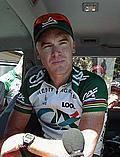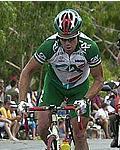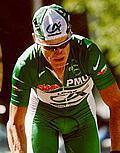
Recently on Cyclingnews.com |
An interview with Stuart O'Grady
Like having new legs
Just a couple of months ago, 2001 Australian Cyclist of the Year Stuart O'Grady and his French Credit Agricole team were winging their way toward another Tour de France and, hopefully, some more of the green and gold he earned in last year's epic ride. But then, last month, the Adelaide rider found himself under the knife in hospital in Lyon with a rather serious blockage in his iliac artery, and facing at least a month of bed rest. What about le Tour?
Cyclingnews reporter Karen Forman spoke to Stuart on the phone last night. What did Stuie say? "I've been on the bike again (and) I'm still doin' it!" Of course, Stuey, we never had ANY doubts . . .
 |
It started as a twinge. An annoying, painful cramp that would strike once every three months, but didn't seem all that important at the time. It was just something that happened during training, and when training is anything up to 1000km a week on a bike, it was natural just to put it down to one of those over-use things that athletes have to cope with in their pursuit of glory.
But then it got worse.
The wretched thing started to come on more often, and even worse, it started occurring during races. Big races. Like in Catalunya in 1997, when he was leading and stood a good chance of winning. But after that cramp came on, instead of finishing first as he had hoped, Stuart finished 19th. And he wasn't real happy. He thought he was just having a bad day.
Still, Stuart keep on doing his thing, just putting the annoying cramp down to bike riding. Just part of the game. One of those things. Bloody annoying, but not disastrous.
The years passed. Stuart was riding well. And he seemed to be dealing with the cramp problem.
But then, when he had to withdraw from the 17th Clasica de Almeria in Spain on March 3 this year because he simply "couldn't pedal any more" Stuart knew that whatever was going on with his left leg was more than just a cramp. Suddenly, he wasn't just thinking about his career, but his life.
What the heck was going on? Why was it, when he had hung on through all the uphill attacks, that this thing was coming on now?
"It had started happening bit more frequently in the past few months," he said, down the phone line from his lounge room in Toulous, France.
"It happened in Adelaide which I won... but then it was a struggle to ride home. Then, after I got to France, I was out training one day and it happened. Then I was in a race, the Clasica, leading. It was then I realised it was a bit more serious, something was definitely wrong. I had been in a break, I had attacked up the climbs, but all of a sudden I couldn't pedal or anything. I had to pull out."
Lucky he decided to seek medical attention. After all, when you have a blockage in a major artery supplying blood to the legs, you are facing a relatively serious situation. Not only is it a threat to your ability to function as a pro cyclist riding for the French Credit Agricole team and heading for more green and gold in the 2002 Tour de France – but it endangers your ability to function as a human being. To be able to walk, run, sit – all those things that most of us take for granted. Things that need a blood supply to be able to function efficiently.
 |
"I had been feeling some pretty weird sensations for a while," Stuart said. "My first recollection of it happening was about five years ago. Then it was happening once every three months, but it never bothered me so much. I never thought it would need an operation or anything. The symptoms were similar to other symptoms you get. I just thought it was just cramp or you know, I was training wrong. I put it down to fatigue. But I was finding that as soon as it locked up, that was it. There was nothing I could do to get rid of it. Still, as long as the road was flat and I was not in a hurry, I could get home."
Doctors ordered a Dopler test, which is basically like a VO2 max.
"You get on the bike and go flat out and straight after they take your blood pressure in both ankles," Stuart explained. "If there is a difference in the reading, you're in trouble. They can see whether the blood is getting down to your feet."
Stuart's tests showed he was in trouble.
The common iliac artery – one of two main arteries going down each leg from the heart, each about five centimetres long – was blocked.
Medical journals will tell you the importance of the iliac arteries. They diverge from the termination of the aorta, pass downward and lateralward, and divide, opposite the intervertebral fibrocartilage between the last lumbar vertebra and the sacrum, into two branches, the external iliac and hypogastric arteries; the former supplies the lower extremity; the latter, the viscera and parietes of the pelvis.
Stuie was happy and not so happy to hear the diagnosis.
"At first it was kinda good to know this was finally the problem, it was a relief," he said. "But at the same time it meant I needed surgery ASAP and that meant I had to stop the season straight away."
With his dream of an even better result than last year in the 2002 Tour de France disappearing by the minute, Stuart was lucky to find a doctor in Lyon who could get the ball rolling immediately.
"Normally there's a month or two waiting list in France, but I was lucky," Stuart said. "The doc, kind of through the team, was able to get the op moved forward, to a week later. And it meant I could probably still do the Tour."
Stuart was in surgery for four hours so the surgeons could remove the "kinked bit" and in hospital for a week.
"You are basically bedridden, you cannot get up," he said. "When the chiropractor came two days later for rehab, I tried to stand up and almost fainted straight away. That's when it hit home that this was scary... I couldn't even get to the door of my room. Yet here I was, hoping to get to the Tour de France."
 |
He said the piece they cut out was one of the worst blockages his surgeon had seen. " He downloaded some digital pix taken during the operation and gave them to me," he said. "He was pretty amazed that I didn't have more problems."
As to why Stuart ended up with a kinked artery is anyone's guess. But cycling obviously played a major part in it.
"They don't know the exact cause." Stuart said. "I did quite a few extra tests in the research, but they just don't know what makes the blockage.
"Being in a cycling position, puts a lot of pressure on that part of the vein that blocks up. The doctor figured out I had done 350,000km since I been a cyclist since I was 16, so obviously it had something to do with that."
The good news is that after a month of no activity – which is a high risk period for patients following such surgery due to the possibility of high blood pressure and internal bleeding – Stuart is back on the bike.
"I got on a week ago, but only for a 20 minute effort," he said. "Things felt a bit funny but nothing was sore, I got through it okay. And yesterday, I had my first hour ride on the road and felt okay. I am fresh and my heart rate is pretty high."
He said after all that time off the bike so early in the road season, it was great to be out on the road again.
"From now on it is a constant build-up. In two weeks I will be on the bike for three to four hours," he said. "Obviously there has been a radical change to the program. Instead of doing the classics as I had hoped, I start off my season with the Tour of Picardie (France), I think May 17, then two tours in Germany – the Tour of Germany and Bayern-Rundfahrt.
"Everything is still scheduled for the Tour – that's why the operation was done ASAP. I have got a month training now and when I start racing again in mid-May, that still leaves me six to seven weeks of full-on racing and training.
"It wasn't the start I had hoped for, but you have to take the positive points out. I am very motivated already. I am not tired getting hammered through Paris-Roubaix. It has been interesting watching the classics, especially the P-R and Flanders. I had never seen them on TV before. Watching them on TV makes you realise the importance of positioning in those races. You know it, but when you see it on TV that really confirms it. It is really important to be up the front."
It was also a little inspiring.
"Another positive point was seeing guys like Museeuw in his mid 30s winning that kind of race," he said. "I am 27..."
Stuart's operation might have been serious, but it certainly wasn't unusual. At least, not in the cycling community.
"There have been six guys my team had the same operation. One of my good friends had it," he said.
"He told me that when I come back I will have two working legs and will feel a bit different. That means not having a leg that keeps locking up."
 |
Unfortunately, while Stuart has been recuperating, his Credit Agricole Team has not been doing all that well without him.
"Actually they are going pretty bad, besides Voigt who had a win," he said.
"But then, Credit Agricole have a history of not getting their act together at the start of the season and doing it pretty slowly.
"When the good team is together it is really strong, but we all have to be there and be clicking together... got to have confidence and start riding well. Get it together.
"It hasn't been a real lucky year. Mer broke his collarbone at the start of the year as well and has been out."
Still, despite his tough luck and his team's misfortune, Stuart O'Grady is feeling very motivated and ready to get back on the back.
"As I said, I am fresh in the mind now, knowing I will have no further problems with my leg. I know I am not going to come out in my first race and kick butt. It will be a slow process in building up and put everything on the Tour again – but I can't wait!"
